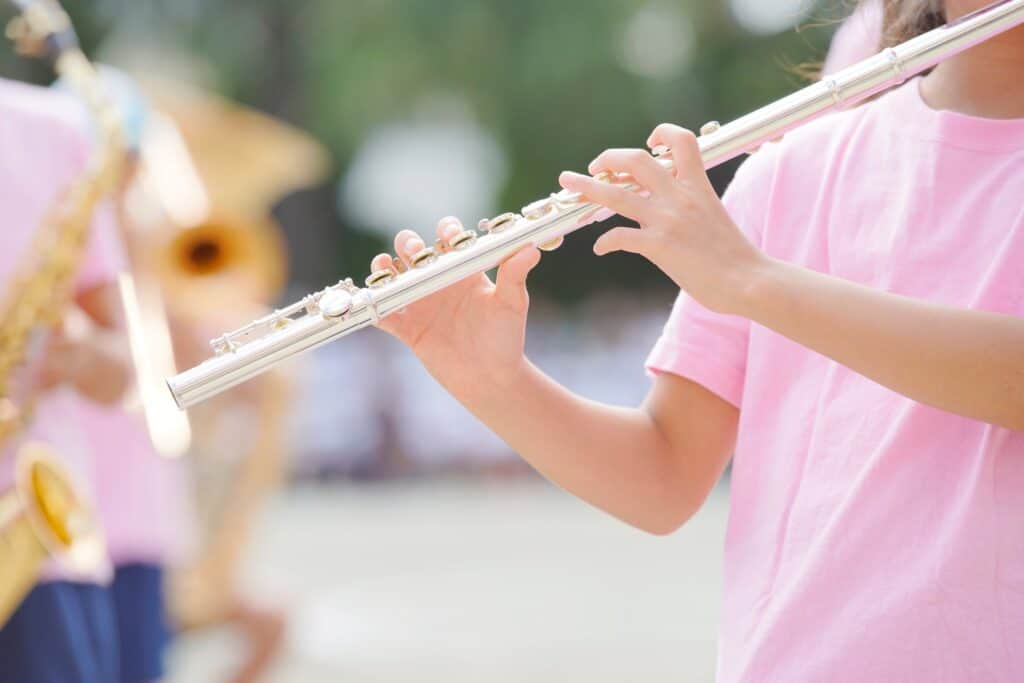Are there flutes in college marching bands?
When most people think of marching bands, their first thoughts go to the large brass section with trombones, tubas, and trumpets. However, there are many other instruments that are vital parts of these ensembles, even though they can be easy to overlook.

There are flutes in college marching bands. They are part of the woodwind section, and some colleges can have more than 40 flute players in a single band! Flutes and piccolos are very similar instruments and both are known to be present in most marching bands.
Flutes make an important contribution to the woodwind section and to the marching band as a whole. Read on to learn about how many flutes are generally in a college band, what kinds of flutes there are, and even some information on marching with a flute.
Kinds of Flutes in College Marching Bands
Even those who are aware of the woodwind section in a marching band are likely unfamiliar with the specific kinds of flutes that are generally used. Typically, there are two different kinds of flutes that are played in college marching bands.
The first is the traditional flute and is the most common. A standard concert flute is typically around 26 inches long and is played while held perpendicular to the ground, with the long end pointing away from the face. These are the most well-known kind of flutes to be played.
In addition to traditional concert flutes, there is also another kind of flute that is also played in marching bands. These are known as piccolos. The Piccolo is a small woodwind instrument that plays high pitches.
In fact, the piccolo is the highest-pitched instrument of the woodwinds in most bands! Sometimes referred to as “baby flutes”, piccolos are about half the size of a normal flute with a length of approximately 13 inches overall.
However, the length is not the only part of a piccolo that is smaller than a flute, the inner tube of a piccolo is narrower by about one-quarter inch than the concert flute. This smaller tubing allows the instrument to play even higher tones than other closely related woodwinds.
So, while there are both flutes and piccolos in many marching bands, these two woodwinds do provide different contributions of sound to the ensemble. While there are generally many flute players marching, it is very common for there to be only a small handful of piccolo players in a marching band.
There are fewer piccolo players because the instrument plays such high notes that they can easily overpower even the largest of bands, simply because the ear is naturally inclined to higher pitches.
Marching With a Flute
For those that already play the flute comfortably, joining a marching band will not add too much additional training. Each flutist must be aware of their instrument and how it works so that they are able to produce the best possible quality of sound as they perform and practice.
The importance of playing with good posture will be more important than ever. It will likely require additional attention due to the fact that flutists in a marching band will be required to move and be a part of larger formations with the band as a whole rather than standing or sitting still as is done in concert bands.
Luckily, a flute doesn’t weigh very much, and will not be an incredibly large burden to marchers when performing. In fact, the flute and piccolo are the two most light-weight instruments that can be played in a marching band.
The average flute only weighs approximately 1.13 lbs or 18 oz. But size can vary slightly depending on the model and material of the specific flute. Even though the flute is not a heavy instrument, it is normal for your arms to grow sore after playing one in a marching band.
These practices and performances require flutists to keep their arms up and straight for extended periods of time. Any large changes or laziness in posture will impact the way the band looks to the audience, draw attention to the offending player, and result in negative sound production as well.

Weather Limitations and Playing Outdoors
Most marching bands perform in outdoor stadiums. This exposes instruments and instrumentalists to the elements in a variety of ways. Woodwind instruments specifically are highly affected by both rain and moisture. In the case of a rainstorm, it is best to protect the flute from being completely soaked by the rain, avoiding contact as much as possible.
For this reason, marching band performances are prone to be canceled or postponed when rain is likely. However, rain is not the only kind of weather that can cause problems for flutes, so marchers must be familiar with their instruments.
As every good flutist knows, there are three main parts to the instrument: the head joint, the body, and the foot joint. Before performing with a marching band, or any other kind of ensemble, the flutist must properly assemble the instrument.
The head joint has a lip plate that is located over the top whole where the flutist will place their mouth when playing. This head joint should be attached by the barrel to the body piece. The foot joint of a flute refers to the bottom-most part of the flute.

Extreme temperatures can impact a flute negatively if not properly cared for. For newer flutists, this will be something that should be learned and understood before participating in a marching band, especially at a college level.
Many people believe that cold temperatures will cause the flute to shrink and would make playing sound sharp. Oddly enough, however, flutes are more likely to sound flat in colder weather because of the way that sound travels through colder air.
It is also wise to have gloves of some kind to keep your fingers warm and agile. Fingering is essential to playing the flute, and these are some of the first body parts to lose feeling in cooler temperatures.
In contrast, extreme heat can also make it difficult to store and play the flute. While playing the flute, sweaty skin and fingers can make it difficult to perform at your best. As far as storing is concerned, know that there is a type of glue that is used to keep pads sitting underneath each key of the flute.
When exposed to extreme heat, the glue can literally melt off, causing the keys to fall off of your flute as well! Marching band performers need to be especially careful with their instruments when playing outdoors.
